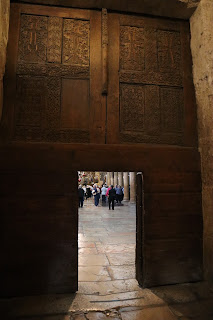Jerusalem is a sacred city to three major religions: Christian, Jewish, and Muslim, which creates a lot of conflicts, and a lot of pilgrims. I was thrilled to be seeing in person the places that I had long heard about and studied in school. It was difficult to reconcile the Jerusalem and Bethlehem I had envisioned with the towns I was driving through. Both cities are modern cities with modern problems of construction, traffic, dirtiness, and crowds. And yet, right in the middle of all the action, was suddenly something holy, something meaningful and spiritual.
Our guide for the day was Murray from Borough Park, Brooklyn, New York, who has lived in Israel for 50 years. I was on the Christian tour, so we focused on locations meaningful to Christian religions. Our first stop was at the Mount of Olives. We were able to see the Harmon Ha Natziv, a Jewish cemetery going back to the days of the biblical kings. We could also see the Old City Wall and the Dome of the Rock.
Beside The Church of All Nations is the Garden of Gethsemane, a peaceful garden with ancient olive trees where Judas betrayed Christ. The church was built in 1924 with funds from many different countries and is said to enshrine the Rock of Agony, where Jesus prayed prior to his arrest.
We then went to the Jewish Quarter to see the Western Wall.
The Western Wall is a portion of the Temple Mount retaining wall built during the time of Herod the Great. During Christian Roman rule, Jews were barred from entering Temple Mount (except once a year), so they began to pray at the Western Wall as it is the closest place to Temple Mount they were allowed to pray. It now stands as a prayerful place for Jews, Christians and Muslims, as the site holds religious meaning for all three religions.
The square was teeming with people. Mondays and Thursdays are busy at the Western Wall, as those are the days the Torah is brought out and many families host bar mitzvahs. Happy celebrations were everywhere, music and dancing, while tourists watched on (and sometimes joined in).
The area at the actual Wall was dedicated to prayer and very respectful. You could feel the change in the air as you walked closer through the people in quiet prayer and reflection to find a spot on the wall to place your hand and offer up your private thoughts. As is tradition, people write down their prayerful intentions and stuff them into the cracks of the wall.
I can think of only two other times in my life when I was completely overcome by emotion that seemingly came from outside and inside me at the same time and welled up into tears. The first time was when I touched the hand of Mother Teresa, the second was when I saw the coast of Ireland for the first time, and when I placed my hand on the Wall was the third time.
The grotto inside the Basilica is traditionally where Jesus is believed to have been born, and is the oldest Christian site continuously used as a place of worship. Constantine the Great ordered a church built on the site. It was later destroyed, and rebuilt by Emperor Justinian.
The Church of Saint Catherine is adjacent to the Basilica and is where most of the caves below the basilica can be accessed.
Our local guide lives in a neighborhood of Bethlehem called Shepherd’s Field. It has rock walls, stony green fields, and modest homes in a valley. It was easy to imagine shepherds gathered there on a starry night.
It took us twice the amount of time it should have to get around Jerusalem that day due to unbelievable traffic. Our bus driver did an amazing job weaving that behemoth through narrow streets and back ways to get us where we needed to be. All the traffic was due to the protests against the government’s attempt to change the judiciary. So shops started closing early, major roadways were blocked, and there was a call for a general strike. The airport was going to be closed, and they closed the port to inbound ships. We got back a bit later than all-aboard, but everyone was on the ship by 8:30 pm. But we couldn’t find anyone from the port to cast off our lines and get permission to leave. There was a bit of a scare that we may get stuck in the port, but by 10:00 we were underway.
I made no new friends in Bethlehem; the only dog I saw was taking a poop on the side of the road, and the only cat I saw was rifling through a trash can. I’m so very glad I got to experience these places, but I was disappointed by some of the realities of the modern world.






























Comments
Post a Comment